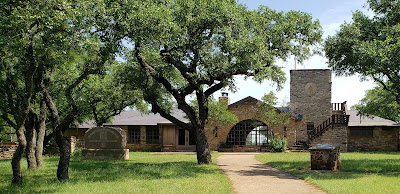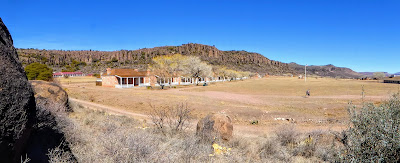This park's location is important not because of the landscape, but because of it's historic significance. Stephen F. Austin chose this area as home base for establishing Anglo-American colonies in Texas. The historic plaque commemorating the site of Austin's colony explains the details.
The place to start for a background on Texas's birth and fight for independence is the museum, known officially as San Felipe de Austin State Historic Site. This is the location, on the highway just outside the park entrance, is where Steven F. Austin first established his colony in 1823. The colony grew to become the social, economic, and political center of American immigration to Texas before independence.
This life-size sculpture greeted us at the entrance to the museum
The museum includes a variety of period artifacts, murals and other artwork that provide an overview of life at the time. The gift shop has a variety of the usual items for sale, and the staff are readily available to answer questions.
Outside the walls of the museum one enters into a small village of log buildings, all well maintained and often populated with volunteers dressed in period clothing and going about their daily chores. On the day we visited there was only one, a blacksmith. He happily explained his tools and the project he was working on.
We planned only a short trip, as we're approaching Christmas and there's a lot to do to prepare for Santa's visit, so we only had time for one more site visit. The Attwater Prairie Chicken National Wildlife Refuge is only a 30 minute drive (19 mi.) northeast of the campground. It's a great place to get an overview of the amazing natural history in this coastal plains environment.
The center moved into a new facility not too long ago and they are still getting organized so they weren't officially "open" when we visited. There was an employee in the building however, and when she saw us watching the video of the Prairie Chicken Dance in the entrance area she happily opened the door so we could visit inside. The collections and displays are all focused on explaining the importance of protecting the species, their traits and the overall ecology of the area.
The displays in the visitor center include an extensive taxidermy bird exhibit and some lovely artwork by students. The activities the staff plan for busy seasons are clever and entertaining for everyone, but especially suited for school age children.
Browse the photos in our photo album for this visit to get better idea of the scenery and the museum itself. The center's official grand opening is expected to be in the spring for their "Boom and Bloom" festival (The 2023 Attwater's Prairie-Chicken Festival, Booming and Blooming Festival will take place on the second weekend of April, unless it falls on Easter weekend, in which case it will be the previous weekend.)
The "boom" is the male performance during mating season, and the video in the entrance lobby shows staff members and visitors demonstrating the steps to this "dance" ritual. It's a really entertaining way to introduce some rather interesting animal behavior! Here is a short but amusing video explaining the purpose for the "boom" dance, and a more scientific 8-minute video exploring the issues around the survival of this species as well as the steps being taken to assist in their survival.
There are several bird blinds around the nearby pond and a short trail so it's easy to get good viewing angles, also a nice place to set up your easel or camera.
The town nearest the campground is Sealy. It's a small town, but necessary services like groceries are available, there's a Walmart so you can pick up whatever you forgot, and there are several choices for restaurants, auto parts, etc. We drove around in town on the first day in the park just to get our bearings. There are a few interesting shops in the old original downtown area too. . . including a quilt shop! If you're a quilter, look for the Wooden Spool.
The park gift shop has an extensive collection of T-shirts, hats, stuffed toys, games and collectables. Sites are all pull-thru, nicely spaced in the wooded area. Many have large grassy areas that are perfect for kids or campers with pets.
Restrooms are nice, clean, well designed with shower accommodations for individuals using wheelchairs in all - men's, women's, two family and one "handicapped" restroom.
The campground is surrounded by multiple walking/biking trails that all seem well maintained.
We really enjoyed wandering through the woods, especially since the weather was mild. The birds were fairly active, and we found a few stray wildflowers still blooming here and there. The low-lying portions of trails that get flooded frequently often have some sort of bridge or boardwalk over them. A local bicycle club has helped to put in and maintain many of the trails sections.
Time to head for home. This was a nice respite in a busy season.



















































